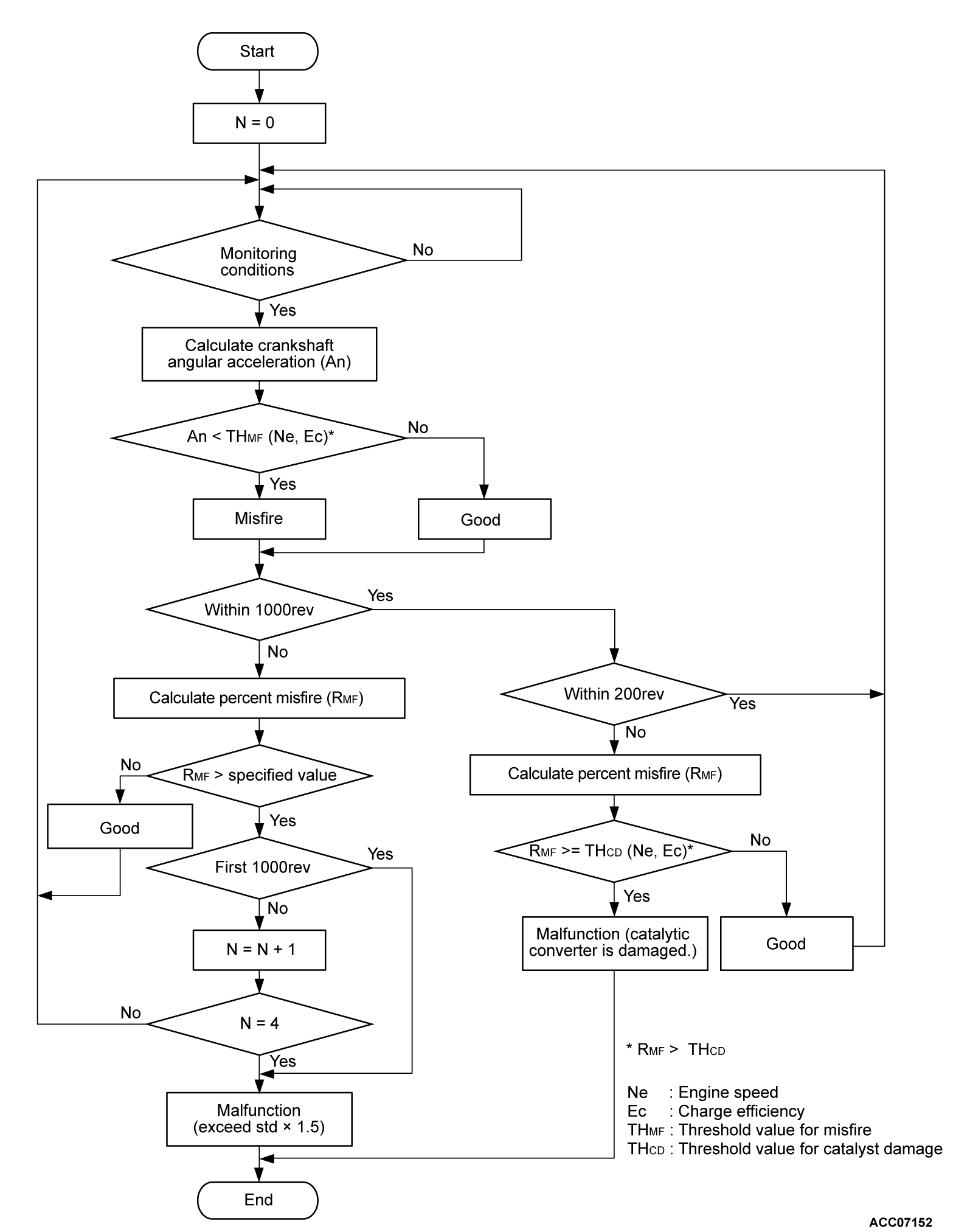DTC P0301: Cylinder 1 Misfire Detected
TECHNICAL DESCRIPTION
- If a misfire occurs while the engine is running, the engine speed changes for an instant.
- The ECM checks for such changes in engine speed.
DESCRIPTIONS OF MONITOR METHODS
- Monitor angular acceleration of crankshaft and detect malfunction when negative variation of the angular acceleration is large.
MONITOR EXECUTION
- Continuous
MONITOR EXECUTION CONDITIONS (Other monitor and Sensor)
Other Monitor (There is no temporary DTC stored in memory for the item monitored below)
- Not applicable
Sensor (The sensor below is determined to be normal)
- Camshaft position sensor
- Mass airflow sensor
- Engine coolant temperature sensor
- Intake air temperature sensor
- Barometric pressure sensor
- Throttle position sensor
DTC SET CONDITIONS
Check Conditions
- Engine speed is between 438 and 6,594 r/min.
- Engine coolant temperature is more than -10°C (14°F). (However, 20°C (68°F) when the engine coolant temperature at engine start is -10°C (14°F) or less).
- Barometric pressure is more than 76 kPa (22.4 in.Hg).
- The engine load is with in the positive torque load.
- Adaptive learning is complete for the vane which generates a crankshaft position signal.
- While the engine is running, excluding rough road driving <M/T> sudden acceleration/deceleration and fuel shut-off operation.
Judgment Criterion (change in the angular acceleration of the crankshaft is used for misfire detection)
- Misfire has occurred more frequently than allowed during the last 200 revolutions [when the catalyst temperature is more than 1,000°C (1,832°F)].
or
- Misfire has occurred more than in 2.0 percent of the first 1,000 revolutions (corresponding to 1.5 times the limit of emission standard).
or
- After the first 1,000 revolutions, the following criterion is satisfied 4 times cumulatively.
- Misfire counts per 1,000 revolutions exceeds in 2.0 percent (corresponding to 1.5 times the limit of emission standard).
FAIL-SAFE AND BACKUP FUNCTION
- The supply of fuel to the misfiring cylinder can possibly be cut.
TROUBLESHOOTING HINTS (The most likely causes for this code to be stored are:)
- Ignition system related part(s) failed.
- Low compression pressure.
- ECM failed.
DIAGNOSIS
Required Special Tools:
- MB992744: Vehicle communication interface-Lite (V.C.I.-Lite)
- MB992745: V.C.I.-Lite main harness A
- MB992747: V.C.I.-Lite USB cable short
- MB992748: V.C.I.-Lite USB cable long
- MB991958: Scan Tool (M.U.T.-III Sub Assembly)
- MB991824: Vehicles Communication Interface (V.C.I.)
- MB991827: M.U.T.-III USB Cable
- MB991910: M.U.T.-III Main Harness A (Vehicles with CAN communication system)
STEP 1. Visual check on ignition spark of No. 1 cylinder.
(1) Remove the spark plug and install it to the ignition coil.
(2) Connect the ignition coil connector.
(3) Disconnect all injector connector.
(4) At the engine start, check spark plug produces a spark.
Did it spark?
STEP 2. Check the No. 1 cylinder spark plug.
Refer to GROUP 16, Ignition System - On-vehicle Service - Spark Plug Check And Cleaning  .
.
 .
.Is the spark plug normal?
STEP 3. Check the compression.
![[Previous]](../../../buttons/fprev.png)
![[Next]](../../../buttons/fnext.png)


